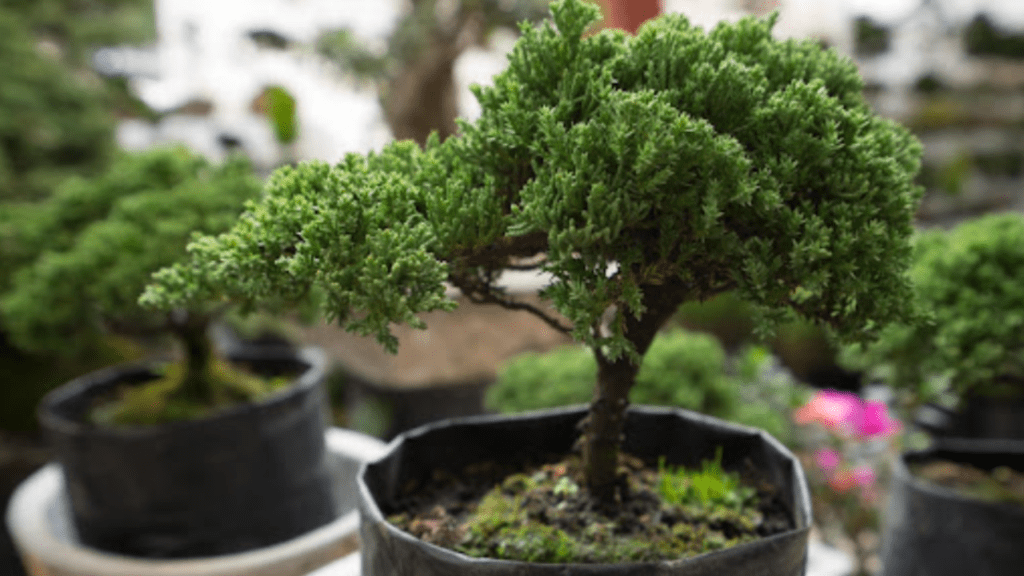
Transform Your Garden with These Stunning Small Japanese Trees
When it comes to creating a tranquil and beautiful outdoor space, Japanese trees are a perfect addition to any garden. These stunning small trees can transform your garden into a peaceful oasis, adding a touch of elegance and charm. In this post, we will showcase a variety of small Japanese trees that are perfect for any garden, and provide information on the best types of Japanese trees to plant and how to care for them. Whether you have a small backyard or a spacious garden, these trees can add a touch of Japan to your outdoor space and create a serene and picturesque atmosphere. So, let’s dive into the world of small Japanese trees and discover how they can transform your garden into a stunning and tranquil retreat.
When it comes to garden design, small Japanese trees play a vital role in creating a serene and picturesque atmosphere. These stunning trees can add a touch of elegance and charm to any outdoor space, whether it’s a small backyard or a spacious garden. The intricate beauty and delicate nature of Japanese trees make them a perfect addition to any garden design. They can be used to create focal points, add depth and dimension, and create a sense of tranquility and balance in the space. Japanese trees also bring a sense of authenticity and cultural significance to the garden, making it a unique and captivating space. With proper care and maintenance, these small Japanese trees can thrive and continue to enhance the beauty of the garden for years to come. Whether it’s the delicate blossoms of the cherry tree or the graceful foliage of the Japanese maple, these trees can truly transform any garden into a stunning and serene retreat.
Table of Contents
ToggleThe Charm of Small Japanese Trees
Historical and cultural significance of Japanese trees.
Japanese trees have a rich historical and cultural significance that adds a unique charm to any garden design. The use of small Japanese trees in garden design dates back to ancient times in Japan, where they were considered an integral part of traditional Japanese gardens. These trees are often chosen for their symbolic meanings and are used to create a sense of harmony and balance in the garden. The intricate beauty and delicate nature of Japanese trees make them a perfect addition to any outdoor space, whether it’s a small backyard or a spacious garden. They can be used to create focal points, add depth and dimension, and create a sense of tranquility and balance in the space. The cultural significance of these trees adds an authentic touch to the garden, making it a captivating and serene space. The meticulous care and maintenance of these trees ensure that they continue to enhance the beauty of the garden for years to come, creating a space that reflects the timeless elegance and cultural significance of Japanese trees.
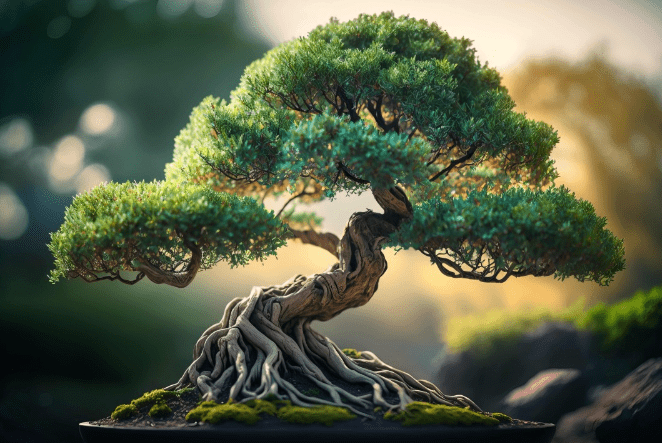
Aesthetic appeal and unique characteristics.
Japanese trees have a rich historical and cultural significance that adds a unique charm to any garden design. The use of small Japanese trees in garden design dates back to ancient times in Japan, where they were considered an integral part of traditional Japanese gardens. These trees are often chosen for their symbolic meanings and are used to create a sense of harmony and balance in the garden.
The intricate beauty and delicate nature of Japanese trees make them a perfect addition to any outdoor space, whether it’s a small backyard or a spacious garden. They can be used to create focal points, add depth and dimension, and create a sense of tranquility and balance in the space. The cultural significance of these trees adds an authentic touch to the garden, making it a captivating and serene space.
The meticulous care and maintenance of these trees ensure that they continue to enhance the beauty of the garden for years to come, creating a space that reflects the timeless elegance and cultural significance of Japanese trees. The aesthetic appeal and unique characteristics of Japanese trees contribute to the overall visual appeal of the garden, making them a popular choice for garden designers and homeowners alike.
Popular Varieties of Small Japanese Trees
Detailed descriptions of popular small Japanese trees, including:
Japanese Maple (Acer palmatum)
Is one of the most popular and widely recognized small Japanese trees. It is known for its stunning foliage, which can range in color from vibrant reds and oranges to deep purples and greens. The delicate, lacy leaves of the Japanese Maple create a beautiful and intricate display, making it a popular choice for adding visual interest to any garden. This tree is also known for its graceful, elegant shape and is often used as a focal point in garden design. With proper care and maintenance, the Japanese Maple can thrive in a variety of climates and soil conditions, making it a versatile and resilient choice for gardeners. Whether used as a standalone tree or as part of a larger garden design, the Japanese Maple adds a touch of timeless beauty and elegance to any outdoor space.
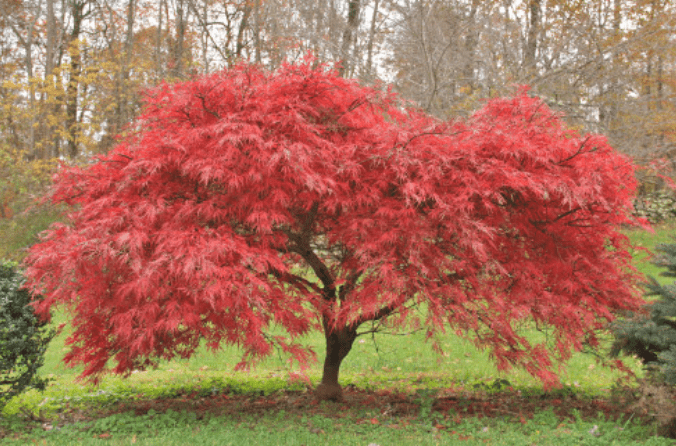
Dwarf Hinoki Cypress (Chamaecyparis obtusa ‘Nana’)
Dwarf Hinoki Cypress is another popular small Japanese tree. It is known for its compact size, making it a great choice for smaller gardens or landscapes. The Dwarf Hinoki Cypress has a unique, pyramidal shape and its foliage is a vibrant green color. This tree is low-maintenance and can thrive in a variety of soil and light conditions, making it a versatile choice for homeowners and gardeners. The compact size and unique shape of the Dwarf Hinoki Cypress make it a great choice for adding visual interest and structure to any garden or landscape. Its distinctive appearance and low-maintenance nature make it a popular choice for adding a touch of Japanese elegance to outdoor spaces.
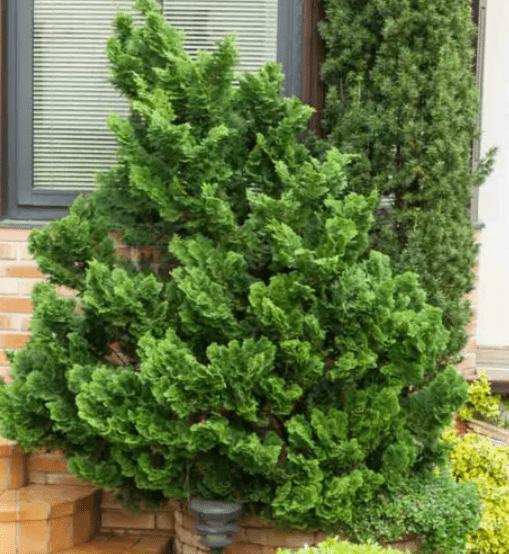
Japanese Stewartia (Stewartia pseudocamellia)
Japanese Stewartia is a beautiful and unique tree that adds a touch of elegance to any outdoor space. It is known for its stunning, camellia-like flowers that bloom in the summer, as well as its vibrant fall foliage. The Japanese Stewartia is a versatile tree that can be used as a standalone tree or as part of a larger garden design. It thrives in well-drained, acidic soil and prefers partial shade, making it a great choice for gardeners looking to add a touch of Japanese beauty to their landscape. With its striking flowers and colorful foliage, the Japanese Stewartia is a popular choice for adding visual interest and beauty to outdoor spaces. Whether used in a small garden or as part of a larger landscape, this tree is sure to make a statement with its timeless beauty.
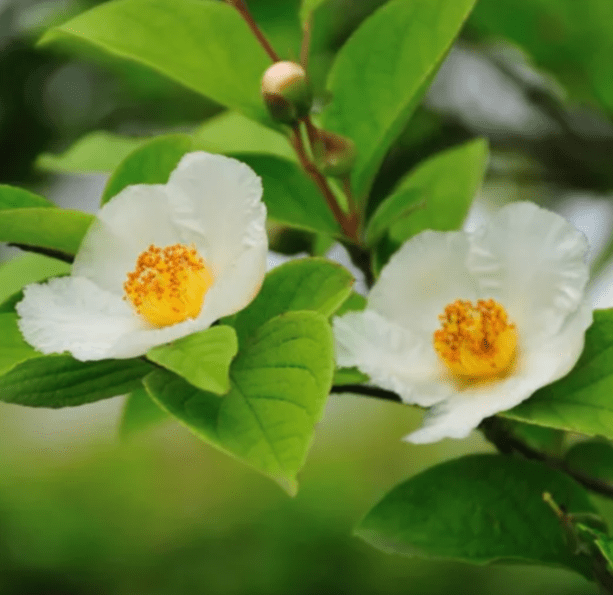
Black Pine (Pinus thunbergii)
Black Pine is a popular choice for adding a touch of Japanese elegance to outdoor spaces. Its distinctive appearance and low-maintenance nature make it a desirable tree for gardeners. With its dark green, twisted needles and rugged bark, the Black Pine is a striking addition to any landscape. It is a hardy tree that can withstand harsh weather conditions and is well-suited for coastal areas. The Black Pine is known for its ability to thrive in sandy, well-drained soil and can tolerate salt spray, making it a great choice for seaside gardens. Its unique appearance and resilience make it a popular choice for adding a touch of Japanese aesthetic to outdoor spaces. Whether used as a standalone tree or as part of a larger garden design, the Black Pine is sure to make a statement with its distinctive beauty.
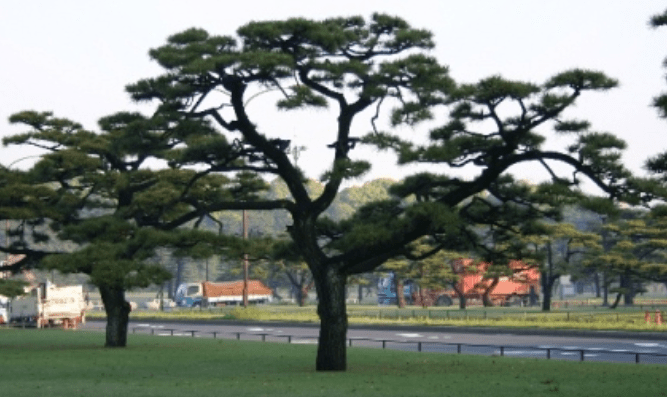
Cherry Blossom (Prunus serrulata ‘Kanzan’)
Cherry Blossom, also known as Prunus serrulata ‘Kanzan’, is a beautiful and ornamental flowering tree that is highly prized for its stunning display of pink, double-petaled blossoms in the spring. These blossoms create a breathtaking sight and are a popular choice for adding a touch of beauty and elegance to outdoor spaces. The Cherry Blossom tree is a symbol of beauty, renewal, and the fleeting nature of life, making it a beloved tree in Japanese culture. It is a relatively low-maintenance tree and can thrive in a variety of soil conditions, making it a versatile choice for gardeners. With its graceful, arching branches and delicate blossoms, the Cherry Blossom tree is a timeless and cherished addition to any landscape. Whether used as a focal point in a garden or as part of a larger outdoor design, the Cherry Blossom tree is sure to bring joy and beauty to any outdoor space.
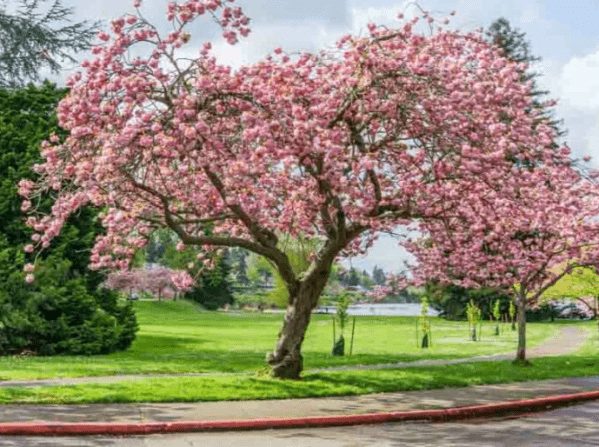
Highlight their unique features and growth habits.
The Black Pine is a unique and striking tree with its dark green, twisted needles and irregular growth habit, making it a standout in any garden or landscape. It is known for its resilience and ability to thrive in various soil conditions, making it a great choice for gardeners looking for a low-maintenance and visually appealing tree. Its growth habit, with branches that twist and turn in different directions, adds an element of interest and character to the tree. The Cherry Blossom tree, also known as Prunus serrulata ‘Kanzan’, is a beautiful and ornamental flowering tree that is highly prized for its stunning display of pink, double-petaled blossoms in the spring. These blossoms create a breathtaking sight and are a popular choice for adding a touch of beauty and elegance to outdoor spaces. The Cherry Blossom tree is a symbol of beauty, renewal, and the fleeting nature of life, making it a beloved tree in Japanese culture. It is a relatively low-maintenance tree and can thrive in a variety of soil conditions, making it a versatile choice for gardeners. With its graceful, arching branches and delicate blossoms, the Cherry Blossom tree is a timeless and cherished addition to any landscape. Whether used as a focal point in a garden or as part of a larger outdoor design, the Cherry Blossom tree is sure to bring joy and beauty to any outdoor space.
Choosing the Right Small Japanese Tree for Your Garden
Factors to consider when selecting a tree:
Climate and hardiness zones.
The Cherry Blossom tree, also known as Prunus serrulata ‘Kanzan’, is a stunning and ornamental flowering tree that is highly prized for its beautiful display of pink, double-petaled blossoms in the spring. This tree is a symbol of beauty, renewal, and the fleeting nature of life, making it a beloved tree in Japanese culture. When choosing the right small Japanese tree for your garden, it is important to consider the climate and hardiness zones. The Cherry Blossom tree is relatively low-maintenance and can thrive in a variety of soil conditions, making it a versatile choice for gardeners. Its growth habit, with branches that twist and turn in different directions, adds an element of interest and character to the tree, making it a timeless and cherished addition to any landscape. Whether used as a focal point in a garden or as part of a larger outdoor design, the Cherry Blossom tree is sure to bring joy and beauty to any outdoor space.
Soil type and conditions.
When selecting the right small Japanese tree for your garden, it is important to consider factors such as climate and hardiness zones. Different trees have different requirements for sunlight, temperature, and soil type, so it is important to choose a tree that will thrive in your specific garden environment. For example, the Cherry Blossom tree, also known as Prunus serrulata ‘Kanzan’, is a beautiful flowering tree that is highly prized for its stunning display of pink, double-petaled blossoms in the spring. This tree is a symbol of beauty, renewal, and the fleeting nature of life, making it a beloved tree in Japanese culture.
In addition to considering climate and hardiness zones, it is also important to consider soil type and conditions. The Cherry Blossom tree is relatively low-maintenance and can thrive in a variety of soil conditions, making it a versatile choice for gardeners. Its growth habit, with branches that twist and turn in different directions, adds an element of interest and character to the tree, making it a timeless and cherished addition to any landscape.
Ultimately, when choosing the right small Japanese tree for your garden, it is important to consider all of these factors to ensure that the tree will thrive and enhance the beauty of your outdoor space.
Available space and mature size.
When selecting a tree for your garden, it’s important to consider the available space and the mature size of the tree. You want to choose a tree that will fit well in your garden and not overcrowd the space as it grows. It’s also important to consider the characteristics of the tree, such as its shape, height, and spread, to ensure it complements the overall design of your garden. Additionally, you’ll want to consider the maintenance requirements of the tree and whether it will fit well with your gardening style and available time for upkeep. By carefully considering these factors, you can choose a tree that will thrive in your garden and enhance the beauty of your outdoor space for years to come.
Planting and Caring for Small Japanese Trees
Step-by-step planting guide
When it comes to planting small Japanese trees in your garden, it’s important to consider a few key factors to ensure the tree will thrive and enhance the beauty of your outdoor space. First and foremost, consider the available space and the mature size of the tree. You want to choose a tree that will fit well in your garden and not overcrowd the space as it grows. Pay attention to the characteristics of the tree, such as its shape, height, and spread, to ensure it complements the overall design of your garden. Additionally, consider the maintenance requirements of the tree and whether it will fit well with your gardening style and available time for upkeep. Once you’ve chosen the right tree, follow a step-by-step planting guide to ensure it gets off to a healthy start. Prepare the soil by digging a hole twice as wide as the root ball and mix in some compost or organic matter. Carefully remove the tree from its container and gently loosen the roots before placing it in the hole. Backfill the hole with soil and water the tree thoroughly. Finally, mulch around the base of the tree to retain moisture and suppress weeds. With proper care and attention, your small Japanese tree will thrive and add beauty to your garden for years to come.
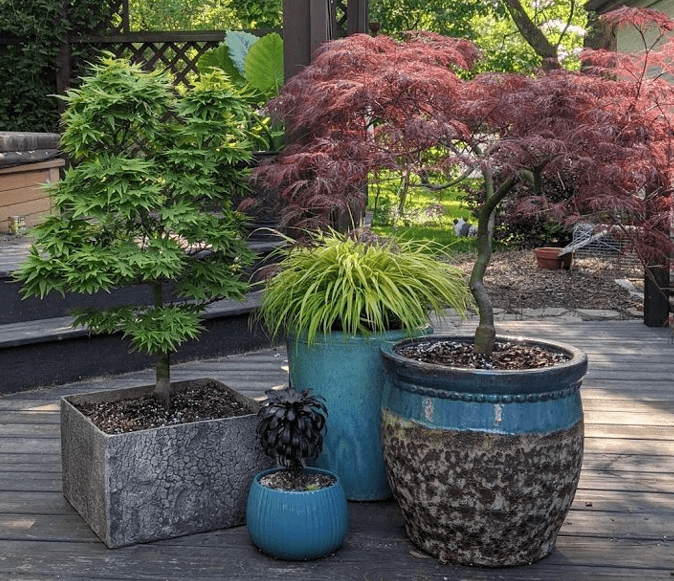
Care and maintenance tips
Care and maintenance tips are essential for keeping your trees healthy and thriving. First, it’s important to choose the right tree for your garden and your gardening style. Consider the maintenance requirements of the tree and whether it will fit well with your available time for upkeep. Once you’ve chosen the right tree, follow a step-by-step planting guide to ensure it gets off to a healthy start. Prepare the soil by digging a hole twice as wide as the root ball and mix in some compost or organic matter. Carefully remove the tree from its container and gently loosen the roots before placing it in the hole. Backfill the hole with soil and water the tree thoroughly. Finally, mulch around the base of the tree to retain moisture and suppress weeds. Regular watering, pruning, and fertilizing, as well as protecting the tree from pests and diseases, will also be important for its care and maintenance. With proper care and attention, your small Japanese tree will thrive and add beauty to your garden for years to come.
Designing Your Garden with Small Japanese Trees
Principles of Japanese garden design.
Japanese garden design is based on several key principles, including simplicity, balance, and harmony with nature. These gardens often feature carefully chosen trees, such as small Japanese trees, to create a peaceful and serene atmosphere. When designing your garden with small Japanese trees, it’s important to consider the proper care and maintenance to ensure they thrive. Once you’ve chosen the right tree, follow a step-by-step planting guide to ensure it gets off to a healthy start. Prepare the soil by digging a hole twice as wide as the root ball and mix in some compost or organic matter. Carefully remove the tree from its container and gently loosen the roots before placing it in the hole. Backfill the hole with soil and water the tree thoroughly. Finally, mulch around the base of the tree to retain moisture and suppress weeds. Regular watering, pruning, and fertilizing, as well as protecting the tree from pests and diseases, will also be important for its care and maintenance. With proper care and attention, your small Japanese tree will thrive and add beauty to your garden for years to come. By following these principles of Japanese garden design and taking proper care of your small Japanese trees, you can create a tranquil and stunning garden space.
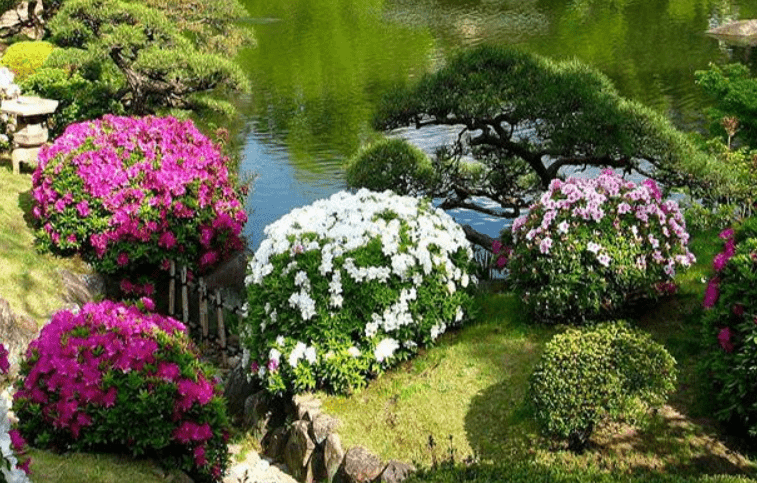
Ideas for integrating small Japanese trees into different garden styles
Japanese maples are a popular choice for integrating small Japanese trees into different garden styles. They can be used in traditional Japanese gardens, where they can be pruned to create a graceful, bonsai-like appearance. They can also be incorporated into modern gardens, where their delicate foliage and vibrant fall colors can add a pop of interest. In a woodland garden, small Japanese trees like the Japanese maple can create a serene and naturalistic atmosphere. In a formal garden, they can be used as focal points or to line paths and walkways. Consider planting small Japanese trees in containers to add a touch of elegance to a patio or courtyard. No matter the garden style, small Japanese trees can bring a sense of tranquility and beauty to any outdoor space. With careful planning and attention to detail, you can create a harmonious and visually stunning garden that incorporates small Japanese trees in a variety of ways.
Seasonal Care and Maintenance
Small Japanese trees require specific care and maintenance throughout the year to ensure they thrive and remain healthy. In the spring, it is important to prune any dead or damaged branches and to fertilize the soil with a balanced, slow-release fertilizer. During the summer, it is crucial to water the trees regularly, especially during hot and dry periods. It is also important to keep an eye out for any signs of disease or pest infestations and to take appropriate measures to address them. In the fall, it is important to continue watering the trees and to monitor the changing colors of their foliage. In the winter, it is important to protect the trees from harsh temperatures and to provide them with insulation to prevent damage. By providing consistent care and maintenance throughout the seasons, you can ensure that your small Japanese trees remain healthy and vibrant all year round.
Common Problems and Solutions
One common problem for small Japanese trees is pest infestations. To address this issue, it is important to regularly inspect the trees for any signs of pests and to take appropriate measures to address the infestations, such as using insecticidal soaps or natural predators to control the pests. Additionally, fungal diseases can be a common problem for these trees, especially during periods of high humidity. To prevent and address fungal diseases, it is important to ensure proper air circulation around the trees, avoid overhead watering, and treat the trees with fungicidal sprays as needed.
Another common problem for small Japanese trees is nutrient deficiencies, which can lead to stunted growth and discoloration of the leaves. To address this issue, it is important to regularly fertilize the soil with a balanced, slow-release fertilizer to ensure that the trees receive the necessary nutrients for healthy growth. Additionally, overwatering or underwatering can also be common issues for these trees, leading to root rot or drought stress. It is important to monitor the moisture levels in the soil and adjust the watering frequency accordingly to ensure that the trees remain healthy.
By being proactive in addressing these common problems and implementing appropriate solutions, you can ensure that your small Japanese trees remain healthy and vibrant throughout the year.
In conclusion, adding small Japanese trees to your garden can truly transform the space and create a peaceful and serene atmosphere. These trees not only add beauty but also provide a sense of tranquility to your outdoor space. With the right care and maintenance, these trees can thrive and enhance the overall aesthetic of your garden. Whether you have a small or large garden, incorporating these stunning small Japanese trees can make a significant impact on the overall ambiance of your outdoor space.
Frequently asked questions And Answer
Some popular small Japanese trees for a garden include the Japanese maple, cherry blossom tree, Japanese black pine, and Japanese flowering apricot tree.
Small Japanese trees require regular watering, well-drained soil, and protection from strong winds. Pruning and shaping may also be necessary to maintain their desired appearance.
Small Japanese trees are adaptable and can thrive in a variety of climates, but it’s important to choose a species that is suitable for your specific climate and soil conditions.
Small Japanese trees can bring a sense of tranquility, beauty, and elegance to your garden. They also offer seasonal changes in foliage and blossoms, adding visual interest throughout the year.
Yes, many small Japanese trees are well-suited for compact gardens or urban spaces. Their compact size and graceful appearance make them an ideal choice for adding a touch of Japanese aesthetics to smaller outdoor areas.
